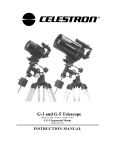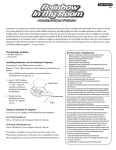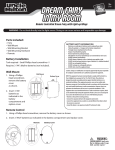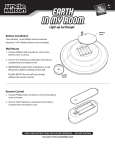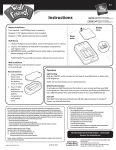Download Uncle Milton Star Theater
Transcript
8+ 2002 AAA/LR03 not included x3 Batteries Requires 3 x 1.5V AAA/LR03 batteries STAR THEATER Home Planetarium ® Download an exciting audio tour of the night sky at UncleMilton.com! Web Code: STAT1143 Discover the Universe! Welcome to the amazing world of astronomy! Astronomers spend their time discovering the nature of space and everything in it. As big as our planet Earth is, it is just one of eight planets orbiting the sun, which is just one of billions of stars in our home galaxy, the Milky Way, which is just one of billions of galaxies in the universe. So you can see that it will be a long, long time, if ever, until astronomers run out of things to discover! Your Own Planetarium Your planetarium allows you to... • Project stars, outlines of the constellations, and their names on the walls and ceiling all around you • Project the night sky of any season or month of the year with its one-piece fully-integrated Star Sphere — no separate overlays to break or lose • Accurately project the night sky by season, date and hour • Project the night sky in its correct directional orientation • Treat yourself and your friends to an exciting sight and sound tour of the night sky. What Is a Constellation? If you look at the stars in the night sky long enough, you will notice how groups of stars form familiar objects, something like connect-the-dots pictures. Many centuries ago, people who gazed at the stars noticed pictures out there— and gave names to them. This helped them create a “map” of the night sky, making it easier to locate the stars. But these figures are not really sitting out there in space. They are only imaginary patterns created by the relative positions of the stars as we see them from Earth. Some stars that appear to be right next to each other are in fact very far apart. They just look close together from where we are looking at them. If you could somehow see the night sky from another part of the galaxy, the relative positions of the stars would be completely different and you would be able to discover totally new constellations. The Star Sphere The Star SphereTM is a replica in miniature of the largest and brightest objects in space surrounding our planet. If you were to imagine Earth inside the sphere, it would be located at the exact center, where the light bulb is. The dots printed on the sphere represent stars. The lines connecting the stars show the constellations. Planetarium Operation The Star Sphere is powered by three 3 AAA/LR03 batteries. Tool required - Small Phillips-head screwdriver SUMMER SPRING SUMMER JUL AUG Battery Cap Screw 1. Remove light wand from base. 2. With a small Phillips-head screwdriver, remove the screw on the battery cap. Unscrew battery cap located at the end of wand. Gently shake the wand so that the battery module slides out. MAR APR SPRING MAY JUN MAY JUN Installing Batteries for the Light Wand Battery Module Battery Cap 3. Insert three 3 AAA/LR03 batteries into battery module, making sure the “+” and “-” ends are in correct placement as indicated on module. Alkaline batteries are recommended. Align Battery Module with groove 4. Insert battery module into light wand, making sure the grooves align. Replace battery cap and Phillips-head screw (do not over-tighten). Place the light wand back into base. CAUTION: Do not look directly into the light source. Doing so can cause serious and irreparable eye damage. Operating Your Planetarium 1. Place planetarium on a table in the center of the room. A room with smooth, light-colored walls and ceiling works best. A room that is roughly square and no larger than 12 x 12 feet provides the best projection quality. Star Theater works best when it is located two to six feet from the projection surface. 2. Date selector is located on the light wand. To set your planetarium for the beginning of the audio tour, rotate light wand until “AUTUMN” lines up with pointer on the base. (The month and date settings and the time ring will be used after the audio tour to set your planetarium for a specific date and time of day.) 3. In a darkened room, turn on projection lamp. (Do not look directly at the Star Sphere while its light is on, or you will lose your darkness adaptation.) Setting the Date and Time You can set your planetarium to project the night sky for any date and hour. Here is how: 1. Setting the date: With projection lamp off, turn light wand until the month you want lines up with the pointer on date selector. Below the month, there are markings indicating the 1st, 10th and 20th of the month. Turn light wand to the left until the date you want lines up with the pointer. For example, if you want to project the night sky the way it is on July 4th, first select July, then turn further to the left, to just past the mark for the first day of the month. Time Ring Date Selector SPRING NOV SUMMER DEC JAN FEB Pointer 2. Setting the time: Once you have selected the month and date, rotate the time ring— without turning the light wand—so that the time at which the sun sets lines up with the pointer. (The time at sunset can be found in the local newspaper or on the Internet.) Now turn the light wand to the exact ti me you want. (Note: The months and dates will change on the date selector as you select the time; once you’ve selected the date and set the time ring for sunset, the time selection function takes over.) You can set your planetarium to project the stars for any time of the night. You can even see what stars are up during the day, when they are not visible. Care and Maintenance Remove batteries when not in use for extended periods. Keep Star Sphere clean with a soft cloth and quality anti-static cleaner/polish. Never use abrasive cleaners. Push a paper clip into this hole to release Star Sphere Bulb replacement: Replacement bulbs are available at most electronics retailers. Halogen bulb, Voltage: 3.6 V, Current: 500 – 600 mA. Part No. LR00001. 1. Remove Star Sphere and light wand from base. 2. Push a paper clip into the small hole directly above the on/off button. At the same time, rotate light wand counterclockwise to Star Sphere. Remove it from Star Sphere. Projection Lamp Projection Lamp Collar Wand 3. Carefully pull old projection lamp out of tip of light wand. 4. Following step should be performed by an adult. Insert replacement bulb into tip of light wand. (Important: Be careful not to bend prongs of the bulb.) Switch light wand on to make sure bulb lights up, then switch it off. 5. Reinsert light wand into Star Sphere. Rotate light wand clockwise until it clicks into place. This is important for accurate date and time adjustments. 6. Place Star Sphere and light wand back into base. The Moving Sky The horizon ring is an important part of your planetarium. It divides the sky into two halves, the visible and the nonvisible. In the course of 24 hours, all of the objects visible from a given location on Earth seem to rise in the east and set in the west. Your planetarium projects stars that are visible from the northern hemisphere. To see all the stars that are visible from the northern hemisphere, slowly rotate the light wand to the left (westward) while the projection lamp is on. Do you notice that some stars around Polaris never set while some of the stars that can be seen from the southern hemisphere (at the opposite pole of the Star Sphere from Polaris) never rise in the northern hemisphere? The Brightest Stars Here are the 25 brightest stars, after the sun, each listed by its common name, the constellation in which it can be found, and the hemisphere from which it is visible: Name Constellation Hemisphere 1 Sirius Canis Major North & South 2 Canopus Carina South 3 Alpha Centauri Centauri South 4 Arcturus Boôtes North & South Rank 5 Vega Lyra North & South 6 Capella Auriga North & South 7 Rigel Orion North & South 8 Procyon Canis Minor North & South 9 Achernar Eridanus South 10 Hadar Centauri South 11 Betelgeuse Orion North & South 12 Altair Aquila North & South 13 Aldebaran Taurus North & South 14 Acrux Crux South 15 Antares Scorpius North & South 16 Spica Virgo North & South 17 Pollux Gemini North & South 18 Fomalhaut Pisces Austrinis North & South 19 Deneb Cygnus North & South 20 Beta Crucis Crux South North & South 21 Regulus Leo 22 Adhara Canis Major North & South 23 Castor Gemini North & South 24 Shaula Scorpius South 25 Bellatrix Orion North & South Exploring The Night Sky Take your time as you cruise the cosmos. Pick out a few of the brightest stars and study the stars near them. Use the constellations to guide you to the dimmer stars that can easily escape the casual observer. For easier star-watching, you will need to give your eyes time to adjust to darkness. Astronomers call this becoming darkness adapted. You will see best after about 20 minutes in the dark. Care care should be taken not to look directly at any bright lights, so you don’t ruin your night vision. Learn More About Astronomy If you want to learn more about the exciting subject of astronomy, check out your school’s library, your local public library, a book store, or the Internet. BATTERY SAFETY INFORMATION - Non-rechargeable batteries are not to be recharged. - Rechargeable batteries are to be removed from the toy before being charged. - Rechargeable batteries are only to be charged under adult supervision. - Different types of batteries or new and used batteries are not to be mixed. - Batteries are to be inserted with the correct polarity. - Exhausted batteries are to be removed from the toy. - The supply terminals are not to be short-circuited. - Do not mix old and new batteries. - Do not mix alkaline, standard (carbon-zinc) or rechargeable(nickel-cadmium) batteries. - Do not dispose of batteries in fire. Battery may explode or leak. KEEP THESE INSTRUCTIONS FOR FUTURE REFERENCE — DO NOT DISCARD Questions? Visit unclemilton.com MANUFACTURED BY UNCLE MILTON INDUSTRIES, INC. P.O. Box 6281 THOUSAND OAKS, CA 91359 USA ©2012 UMI. All rights reserved. ® and TM designate trademarks of Uncle Milton Industries, Inc. MADE IN CHINA 2002-0250-0212







